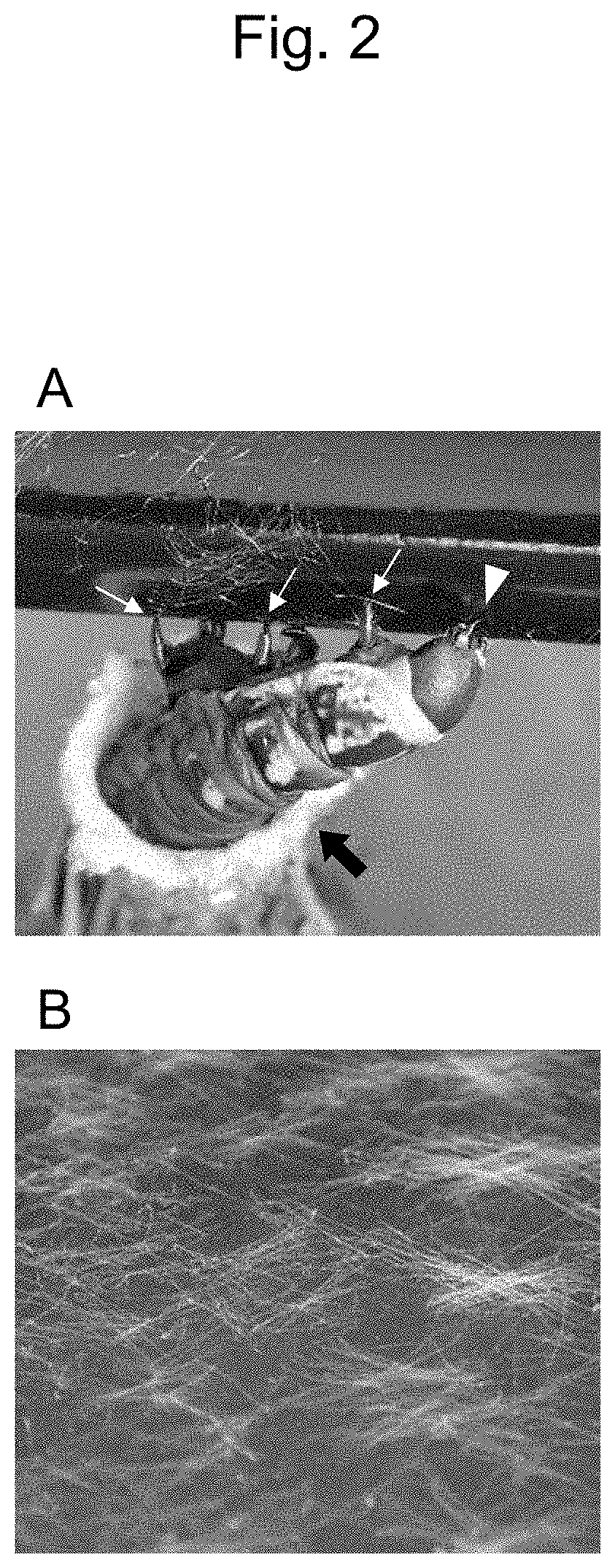Method for producing long bagworm silk threads and production device therefor
- Summary
- Abstract
- Description
- Claims
- Application Information
AI Technical Summary
Benefits of technology
Problems solved by technology
Method used
Image
Examples
example 1
n of Long Bagworm Silk Threads
(Purpose)
[0114]Bagworm foothold silk threads are produced by the method according to the present invention for producing long bagworm silk thread.
(Method)
[0115]As the bagworm, the last instar larvae of Eumeta japonica collected at an orchard in Tsukuba, Ibaraki, Japan t were used (n=50). A production apparatus according to the present invention for long bagworm silk thread was used to produce long bagworm silk threads. An approximately square metal can was used as the production apparatus. In the metal can, a closed ring-like rail with its floor directed upward, which has a width of 1.7 mm and a perimeter of 1.1 m, is on the upper edge of the plate member corresponding to the side surface of the metal can. One bagworm was placed on the inner bottom surface of the metal can. After observing the state that the bagworm was reached the rail and move around the rail with spinning of threads, the bagworm was left on the rail directly for two days (i.e., the s...
example 2
on of Continuous Spinning Behavior of Bagworms
(Purpose)
[0123]Bagworms have a tendency to spin foothold silk threads at least during migration. Accordingly, a bagworm continuously spins a thread as long as the bagworm continues to move on a rail, which also corresponds to the length of bagworm silk monofibers obtained by the present invention. Thus, the inventors examined how many hours bagworms can continue to spin on the apparatus according to the present invention for producing long bagworm silk thread.
(Method)
[0124]As the bagworm, the last instar larvae of Eumeta minuscula collected from trees planted in the grounds of National Agriculture and Food Research Organization, Japan were used (n=8). A stainless dish having a diameter (φ) of 75 mm and comprising a closed ring-like rail, which has a width of 0.85 mm and a perimeter of 235 mm, was used as the production apparatus. After one bagworm was placed on the bottom surface of the stainless dish, the time required for the bagworm t...
example 3
on of Mechanical Properties of Bagworm Silk Threads
(Purpose)
[0129]The mechanical properties of bagworm silk threads were examined.
(Method)
[0130]Spun fibers (bifilaments) obtained before scouring were used as the bagworm silk threads. A portion of the spun fibers obtained after the collection process in Example 1 were used as foothold silk threads (n=9). Additionally, silk threads collected from the innermost layers of nests for the last instar larvae of Eumeta japonica were used as nest silk threads (n=5). After dissecting the Eumeta japonica nests, the samples having a length of about 30 mm from the surface of the innermost layers were manually collected.
[0131]A tensile test was performed on each type of bagworm silk threads to evaluate four different mechanical properties: initial elastic modulus, fracture strength, elongation at break, and toughness. The initial elastic modulus refers to a value given as the initial slope of a stress-strain curve, which corresponds to the proport...
PUM
| Property | Measurement | Unit |
|---|---|---|
| Angle | aaaaa | aaaaa |
| Length | aaaaa | aaaaa |
| Volume | aaaaa | aaaaa |
Abstract
Description
Claims
Application Information
 Login to View More
Login to View More - R&D
- Intellectual Property
- Life Sciences
- Materials
- Tech Scout
- Unparalleled Data Quality
- Higher Quality Content
- 60% Fewer Hallucinations
Browse by: Latest US Patents, China's latest patents, Technical Efficacy Thesaurus, Application Domain, Technology Topic, Popular Technical Reports.
© 2025 PatSnap. All rights reserved.Legal|Privacy policy|Modern Slavery Act Transparency Statement|Sitemap|About US| Contact US: help@patsnap.com



